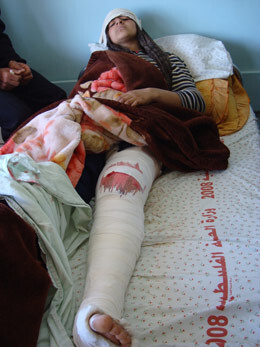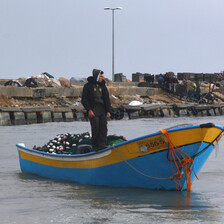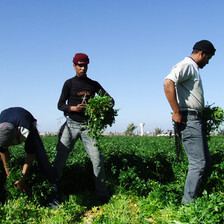The Electronic Intifada 29 June 2009

Seventeen-year-old Wafa al-Najjar was about 800 meters from the border with Israel when she was shot in the kneecap by an Israeli soldier. (Eva Bartlett)
At just after midnight on 3 June, the 17-year-old was walking home from a friend’s house in Umm al-Nassir, a collection of tents and dilapidated houses in the northwest Gaza Strip, just more than 1 kilometer from the northern boundary with Israel.
Days after being pierced by the flechettes, al-Medani’s wounds not only haven’t healed, the darts are still lodged in his neck, shoulder and leg. “The doctor told me that if I don’t feel too much pain, he won’t operate to remove the darts,” the youth said. “I feel light pain still, but what can I do?”
This is not an unusual situation in Gaza, where Israel has repeatedly used the dart bombs. Due to their design, flechettes dig deeply into their target — flesh, cement and metal alike — with their “tails” frequently breaking off, leaving multiple injuries and rendering them nearly impossible to extract without inflicting more injury in the surgical search. In most cases, doctors opt against surgery, leaving the darts inside the victim’s body.
At the time when al-Medani was struck, “nothing was happening,” he said. “I was with my friend, Ahmad, and it was quiet in the area. Until we were hit.” Seventeen-year-old Ahmad Abu Hashish suffered a lighter injury, with a dart to his foot. Both teens were immediately taken to nearby Kamal Adwan hospital in Beit Lahiya, but al-Medani’s injuries being more serious, including the dart dangerously close to his cervical vertebrae, necessitated his transfer to Gaza City’s al-Shifa hospital.
The Palestinian Centre for Human Rights’s (PCHR) weekly report corroborates al-Medani’s testimony that he was hit by the dart bomb. According to PCHR, “At approximately 00:00, IOF [Israeli occupation forces] troops positioned at the border between the Gaza Strip and Israel fired four flechette shells at a Bedouin village in the northern Gaza Strip. The shells landed near a number of Palestinian civilians who were beside their houses, approximately 1,000 meters from the border.”
Also on 3 June, in the Beit Hanoun region, Israeli soldiers fired on Palestinian farmers, injuring two persons who PCHR reports were roughly one kilometer from the border, working on farmland. The two injured farmers, both in their mid-60s, are among the latest casualties of Israeli shelling and firing since the end of Israel’s three-week assault on Gaza in January.
For almost a decade, Israel has unilaterally imposed an off-limits area solely on the Palestinian side of the boundary between Israel and Gaza. This “buffer zone” has ranged from 50 meters wide to more than two kilometers in some northern areas. On 25 May, Israeli authorities officially announced the current boundaries of the buffer zone to be 300 meters, within which anyone walking on the land would be subject to Israeli fire.
Prior to and following the declaration, Israeli soldiers have continued to shell and shoot well beyond 300 meters, targeting unarmed Palestinian civilians and farmers in the vicinity.
On 18 January, the first day of the ceasefire, Israeli soldiers shot 23-year-old Maher Abu Rjaila, from the village of Khozaa in the southeast Gaza Strip, in the chest with live ammunition, killing him. Since then, two more Palestinians were killed, including one child, and 18 injured, all in or near the “buffer zone” area, all by Israeli soldiers’ intentional shooting and shelling.
One month on and several more victims later, on 24 February, 17-year-old Wafa al-Najjar, from the same region, was shot in the knee by an Israeli soldier roughly 800 meters away from the border with Israel. Al-Najjar lost her entire kneecap and faces months of rehabilitation before she can try to walk again.
On 5 June, Khaled Jahjuh was with his seven-year-old son in the Shoka region east of Rafah in the southern Gaza Strip when he was injured. The two were driving away from their land, 1.5 kilometers from the Israeli border, when Israeli soldiers began shooting. An Israeli soldier’s bullet passed through the steel of the truck and into Khaled’s back, at his spine, leaving him unable to walk, and leaving his son psychologically scarred.
As many of those injured by Israeli attacks face uncertain recovery and uncertain futures, it is sure that in the extended “buffer zone” region, the number of casualties will continue to rise.
Eva Bartlett is a Canadian human rights advocate and freelancer who arrived in Gaza in November 2008 on the third Free Gaza Movement boat. She has been volunteering with the International Solidarity Movement and documenting Israel’s ongoing attacks on Palestinians in Gaza. During Israel’s recent assault on Gaza, she and other ISM volunteers accompanied ambulances and documenting the Israeli attacks on the Gaza Strip.




